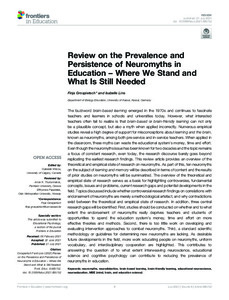| dc.date.accessioned | 2021-10-18T16:15:49Z | |
| dc.date.available | 2021-10-18T16:15:49Z | |
| dc.date.issued | 2021-07-21 | |
| dc.identifier | doi:10.17170/kobra-202110014837 | |
| dc.identifier.uri | http://hdl.handle.net/123456789/13301 | |
| dc.description.sponsorship | Gefördert durch den Publikationsfonds der Universität Kassel | ger |
| dc.language.iso | eng | eng |
| dc.rights | Namensnennung 4.0 International | * |
| dc.rights.uri | http://creativecommons.org/licenses/by/4.0/ | * |
| dc.subject | neuromyths | eng |
| dc.subject | neurodidactics | eng |
| dc.subject | brain-based learning | eng |
| dc.subject | brain-friendly learning | eng |
| dc.subject | educational neuroscience | eng |
| dc.subject | neuroeducation | eng |
| dc.subject | MBE (mind, brain, and education science) | eng |
| dc.subject.ddc | 370 | |
| dc.subject.ddc | 570 | |
| dc.title | Review on the Prevalence and Persistence of Neuromyths in Education – Where We Stand and What Is Still Needed | eng |
| dc.type | Aufsatz | |
| dcterms.abstract | The buzzword brain-based learning emerged in the 1970s and continues to fascinate teachers and learners in schools and universities today. However, what interested teachers often fail to realize is that brain-based or brain-friendly learning can not only be a plausible concept, but also a myth when applied incorrectly. Numerous empirical studies reveal a high degree of support for misconceptions about learning and the brain, known as neuromyths, among both pre-service and in-service teachers. When applied in the classroom, these myths can waste the educational system’s money, time and effort. Even though the neuromyths issue has been known for two decades and the topic remains a focus of constant research, even today, the research discourse barely goes beyond replicating the earliest research findings. This review article provides an overview of the theoretical and empirical state of research on neuromyths. As part of this, ten neuromyths on the subject of learning and memory will be described in terms of content and the results of prior studies on neuromyths will be summarized. The overview of the theoretical and empirical state of research serves as a basis for highlighting controversies, fundamental concepts, issues and problems, current research gaps and potential developments in the field. Topics discussed include whether controversial research findings on correlations with endorsement of neuromyths are merely a methodological artefact, and why contradictions exist between the theoretical and empirical state of research. In addition, three central research gaps will be identified: First, studies should be conducted on whether and to what extent the endorsement of neuromyths really deprives teachers and students of opportunities to spend the education system’s money, time and effort on more effective theories and methods. Second, there is too little work on developing and evaluating intervention approaches to combat neuromyths. Third, a standard scientific methodology or guidelines for determining new neuromyths are lacking. As desirable future developments in the field, more work educating people on neuromyths, uniform vocabulary, and interdisciplinary cooperation are highlighted. This contributes to answering the question of to what extent interweaving neuroscience, educational science and cognitive psychology can contribute to reducing the prevalence of neuromyths in education. | eng |
| dcterms.accessRights | open access | |
| dcterms.creator | Grospietsch, Finja | |
| dcterms.creator | Lins, Isabelle | |
| dc.relation.doi | doi:10.3389/feduc.2021.665752 | |
| dc.subject.swd | Gehirn | ger |
| dc.subject.swd | Neurodidaktik | ger |
| dc.subject.swd | Lernen | ger |
| dc.subject.swd | Pädagogik | ger |
| dc.subject.swd | Bildungsforschung | ger |
| dc.subject.swd | Hirnforschung | ger |
| dc.type.version | publishedVersion | |
| dcterms.source.identifier | eissn:2504-284X | |
| dcterms.source.journal | Frontiers in Education | eng |
| dcterms.source.volume | Volume 6 | |
| kup.iskup | false | |
| dcterms.source.articlenumber | 665752 | |


